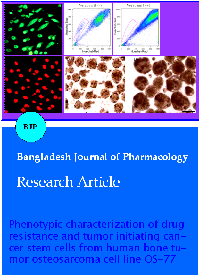Phenotypic characterization of drug resistance and tumor initiating cancer stem cells from human bone tumor osteosarcoma cell line OS-77
DOI:
https://doi.org/10.3329/bjp.v9i3.19891Keywords:
ABC transporter, Cancer stem cell, Drug resistance, Metastasis, VerapamilAbstract
The cancer stem cell theory suggest that presence of small subpopulation of cancer stem cells are the major implication in the cancer treatment and also responsible for tumor recurrence. Based on Hoechst 33342 dye exclusion technique, we have identified about 3.3% of cancer stem like side population (SP) cells from human osteosarcoma OS-77 cell line whose prevalence is significantly reduced to 0.3% after treatment with verapamil. The sphere formation assay revealed that osteosarcoma SP cells are highly capable to form tumor spheres (sarcospheres). Further by immunocytochemistry and RT-PCR, we show that OS-77 SP cells have enhanced expression of stem cell surface markers such as CD44, Nanog and ATP-binding cassette (ABC) transporter gene (ABCG2) which contributes to self-renewal and drug resistance, respectively. Our findings help to designing a novel therapeutic drug which could effectively target the cancer stem cells and prevent the tumor relapse.
Downloads
244
179 Read
163
References
Chang CC. Recent translational research: stem cells as the roots of breast cancer. Breast Cancer Res. 2006; 8: 103-05.
Cheng L. Establish a germ cell origin for metastatic tumors using OCT4 immunohistochemistry. Cancer 2004; 101: 2006-10.
Cho RW, Clarke FM: Recent advances in cancer stem cells. Curr Opin Genet Dev. 2008:18: 48-53.
Damron TA, Ward WG, Stewart A. Osteosarcoma, chondrosarcoma and Ewings sarcoma: National Cancer Data Base Report. Clin Orthop Relat Res. 2007; 459: 40-47.
Ezeh UI, Turek PJ, Reijo RA, Clark AT. Human embryonic stem cell genes OCT4, NANOG, STELLAR and GDF3 are expressed in both seminoma and breast carcinoma. Cancer 2005; 104: 2255-65.
Gibbs CP, Kukekov VG, Reith JD, Tchigrinova O, Suslov ON, Scott EW. Stem-like cells in bone sarcomas: Implications for tumorigenesis. Neoplasia 2005; 7: 967-76.
Goodell MA, Brose K, Paradis G, Conner AS, Mulligan RC. Isolation and functional properfies of murine hematopoietic stem cells that are replicating in vivo. J Exp Med. 1996; 183: 1797-806.
Hemmati HD, Nakano I, Lazareff JA, Masterman-Smith M, Geschwind DH, Bronner-Fraser M. Cancerous stem cells can arise from pediatric brain tumors. Proc Natl Acad Sci USA. 2003; 100: 15178-83.?
Jordan CT, Guzman ML, Noble M. Cancer stem cells. N Engl J Med. 2006; 355: 1253-61.
Kondo T, Setoguchi T, Taga T: Persistence of a small subpopulation of cancer stem-like cells in the C6 glioma cell line, Proc Natl Acad Sci USA. 2004; 101:78186.
Lee J, Kim HK, Rho JY, Han YM,Kim J.The human OCT-4 isoforms differ in their ability to confer self-renewal. J Biol Chem. 2006; 281: 3554-65.
Li C, Heidt DG, Dalerba P, Burant CF, Zhang L, Adsay V. Identification of pancreatic cancer stem cells. Cancer Res. 2007; 67: 1030-37.
Looijenga LH, Stoop H, deLeeuw HP, De Gouveia Brazao CA, Gillis AJ, vanRoozendaal KE, van Zoelen EJ, Weber RF, Wolffenbuttel KP, van Dekken H, Honecker F, Bokemeyer C, Perlman EJ, Schneider DT, Konenen J, Sauter G, Oosterhuis JW. POU5F1 (OCT3/4) identifies cells with pluripotent potential in human germ cell tumors. Cancer Res. 2003; 63: 2244-50.
Marina N, Gebhardt M, Teot L, Gorlick R. Biology and therapeutic advances for pediatric osteosarcoma. Oncologist 2004; 9: 21-22.
Okita K, Ichisaka T, Yamanaka S. Generation of germline-competent induced pluripotent stem cells. Nature 2007; 448: 313-17.
Pardal R, Clarke MF, Morrison SJ. Applying the principles of stem-cell biology to cancer. Nat Rev Cancer. 2003; 3: 895-902.?
Su J, Xu XH, Huang Q, Lu MQ, Li DJ, Xue F, Yi F, Ren JH, Wu YP. Identification of cancer stem-like cd44 cells in human nasopharyngeal carcinoma cell line. Arch Med Res. 2011; 42: 15-21.
Wang L, Park P, Lin YC. Characterization of stem cell attributes in human osteosarcoma cell lines. Cancer Biol Ther. 2009; 8: 543-52.
Wu C, Wei Q, Utomo V, Nadesan P, Whetstone H, Kandel R. Side population cells isolated from mesenchymal neoplasms have tumor initiating potential. Cancer Res. 2007; 67: 8216-22.

Published
How to Cite
Issue
Section
License
Authors who publish with this journal agree to the following terms:
- Authors retain copyright and grant the journal right of first publication with the work simultaneously licensed under a Creative Commons Attribution License that allows others to share the work with an acknowledgement of the work's authorship and initial publication in this journal.
- Authors are able to enter into separate, additional contractual arrangements for the non-exclusive distribution of the journal's published version of the work (e.g., post it to an institutional repository or publish it in a book), with an acknowledgement of its initial publication in this journal.
- Authors are permitted and encouraged to post their work online (e.g., in institutional repositories or on their website) prior to and during the submission process, as it can lead to productive exchanges, as well as earlier and greater citation of published work (See The Effect of Open Access).
